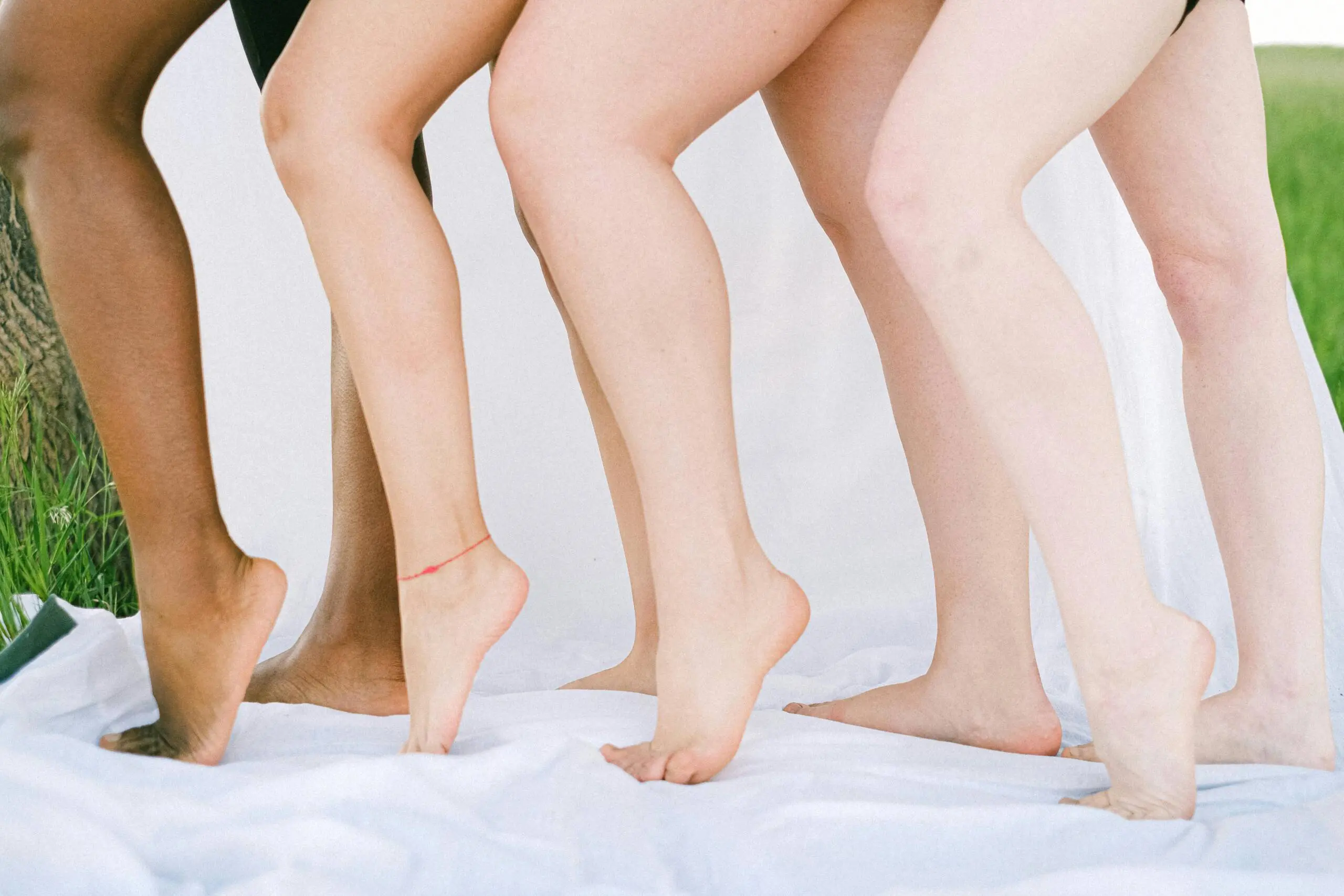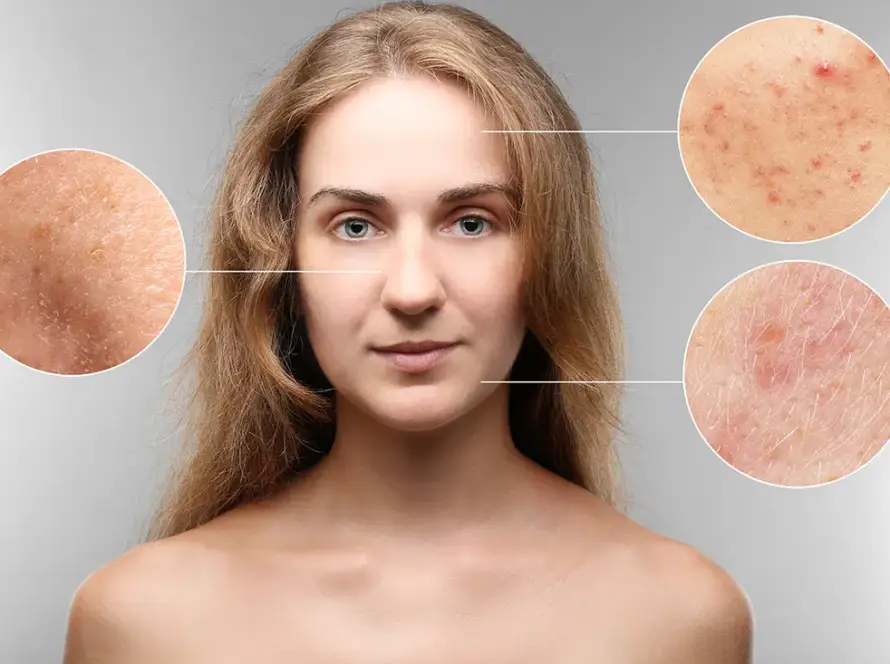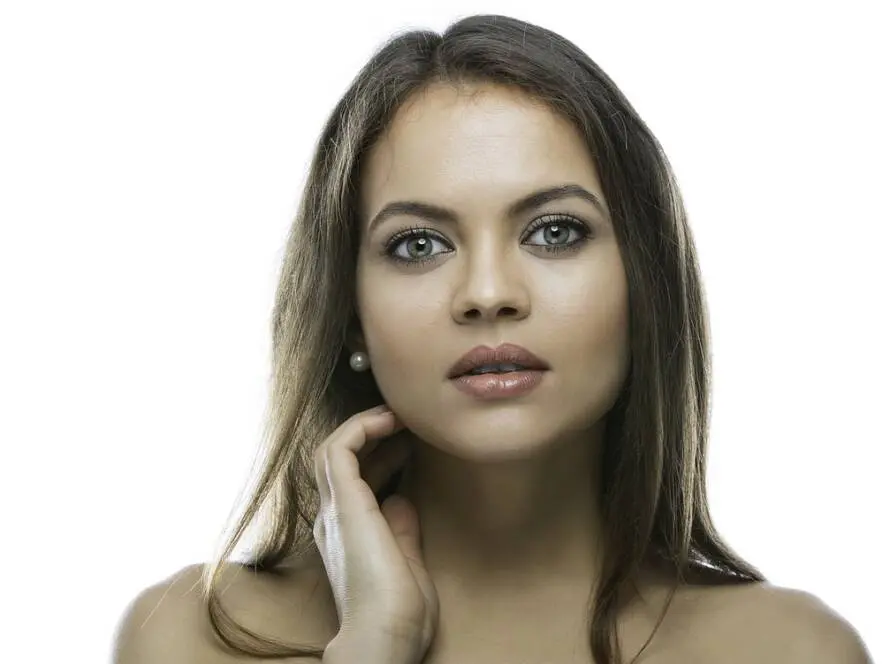If you’ve noticed thin, web-like veins on your skin, you’re not alone. These ‘thread veins’, which are actually not veins at all but rather small blood vessels, affect up to 88% of women and 79% of men according to some studies, and while often harmless, they can be frustrating to deal with.
So, what are thread veins, exactly? Thread veins – also known as spider veins or the medical term telangiectasia – are small, thin, visible blood vessels that typically appear close to the surface of the skin. Very small ones are red, then as they get bigger, the colours change through purple and then green. They can look like fine lines, webs, or branches.
Thread veins are most commonly found on the legs or face, but they can appear in other areas as well. Contrary to the popular belief, thread veins can develop at any age. While they become more common as people get older, younger individuals can also be affected if they have a genetic predisposition.
What causes thread veins?
Thread veins are very small blood vessels within the living layer of the skin (the dermis) that have become dilated and visible. This dilation causes these spider veins to become visible on the skin. Some common causes and risk factors include:
1. Genetics
The number one cause is usually a family history of thread veins or varicose veins.
2. Aging
Veins weaken with age, and skin becomes thinner, making veins more visible.
3. Hormonal changes
Pregnancy, menopause, or birth control pills can influence vein health.
4. Sun exposure
UV rays can damage the skin and veins, especially on the face.
5. Prolonged standing or sitting
This can increase pressure in the veins, particularly in the legs.
6. Obesity
Excess weight adds pressure on veins.
7. Injury or trauma
Direct injuries to the skin can cause spider veins in localised areas.
Best treatments for thread veins or spider veins
Treating thread veins is usually straightforward, and most people see good results with minimally invasive procedures. However, the effectiveness of treatment depends on the size, location, and severity of the veins. Multiple treatments may be necessary to reduce or eliminate the appearance of thread veins. Here are some thread vein removal options offered at Blemish Clinic:
1. Sclerotherapy
This is one of the most common thread vein removal options, particularly on the legs. A solution (usually a salt solution or a special chemical) is injected directly into the vein, which causes the vein to scar and collapse. Over time, the vein is absorbed by the body and fades. It’s a minimally invasive procedure that doesn’t usually require anaesthesia. While sclerotherapy often yields visible improvements within a few weeks, full results may require multiple sessions over several months.
o Best for: Leg veins.
o Downtime: Minimal, but compression stockings may be needed for a few days after.
o Effectiveness: Often requires multiple treatments for full results.
2. Laser Therapy
Laser therapy involves the use of strong bursts of light aimed at the spider veins, causing them to fade and disappear. This treatment works best for smaller veins and veins on the face. Newer laser technologies can target the spider vein without damaging the surrounding skin. Even though the results of the laser treatment are often quickly evident, in some cases of larger spider veins, it may take up to three months for the full results to be seen.
o Best for: Small facial thread veins or those in sensitive areas.
o Downtime: Minimal to none, but temporary redness or swelling may occur.
o Effectiveness: May require several sessions.
3. Intense Pulsed Light (IPL) Therapy
Similar to laser therapy, IPL uses broad-spectrum light to target the blood vessels. This treatment is often used for larger areas or for people with fair skin. IPL is especially effective for facial spider veins and can also improve overall skin texture by stimulating collagen production. Normally, only a few sessions of thread vein removal treatment are needed with the Intense Pulsed Light device to reduce the redness and visibility of the thread or spider veins.
o Best for: Facial thread veins and large areas.
o Downtime: Minimal; can cause slight discomfort during the procedure.
o Effectiveness: May require multiple treatments.
How do you stop getting thread veins?
Lifestyle changes can help prevent or manage the development of thread or spider veins and underlying vein conditions like varicose veins. While lifestyle alone may not completely eliminate thread veins, it can improve circulation and reduce the risk of new veins forming. Incorporating these lifestyle habits and self-care tips can help minimise the appearance of thread veins and reduce the likelihood of more serious vein conditions such as varicose veins forming in the future.
Here are some ways lifestyle can make a difference:
1. Exercise regularly
• Physical activity, especially exercises like walking, swimming, or cycling, promotes good circulation and helps prevent blood from pooling in the veins.
• Strengthening leg muscles also supports healthy blood flow in the veins.
2. Maintain a healthy weight
• Excess weight puts additional pressure on your veins, particularly in the legs. Maintaining a healthy weight reduces this pressure and lowers the risk of developing thread veins or worsening existing ones.
3. Avoid prolonged sitting or standing
• Sitting or standing for long periods can lead to poor circulation and increased pressure in the leg veins. If you must stand or sit for long stretches, try to move around or stretch your legs frequently to keep blood flowing.
4. Wear compression stockings
• Compression stockings help improve blood flow by providing gentle pressure that supports vein function. They’re especially helpful if you’re on your feet for long periods, you’re prone to developing thread veins or already suffering from more serious varicose veins.
5. Elevate your legs
• Elevating your legs above heart level for short periods throughout the day can help improve circulation and reduce pressure on the veins. This is particularly important in case of suffering from painful varicose veins most commonly occurring in legs.
6. Eat a balanced diet
• A diet rich in fibre, antioxidants, and low in sodium can help maintain healthy blood vessels. Fiber helps prevent constipation, which can put pressure on veins, while antioxidants support vein health. Reducing salt intake helps minimise water retention and swelling.
7. Avoid high heels and tight clothing
• High heels can restrict calf muscle movement, reducing circulation in the legs. Opt for lower-heeled shoes to allow the muscles to work properly. Additionally, avoid tight clothing around the waist or legs, as it can restrict blood flow.
8. Protect your skin from the sun
• Excessive sun exposure can damage skin and veins, particularly on the face, making thread veins more likely to develop. Wearing sunscreen can protect your skin and help prevent the appearance of veins.
Can thread or spider veins lead to varicose veins?
Many patients who come to us about their thread veins do so as a cosmetic concern, but thread veins can sometimes indicate underlying conditions. In many cases, thread or spider veins may be linked to hidden varicose veins, which are larger, deeper veins that can feed the smaller, visible veins on the surface. If left untreated, these underlying varicose veins could lead to more serious issues like swelling, pain, or even venous insufficiency. It’s important to explore the causes of thread veins with a medical professional, especially if they cause discomfort, pain, or swelling. They may recommend diagnostic tests like an ultrasound to identify any deeper vein problems.
If you’re concerned about thread veins, consider consulting a specialist at Blemish Clinic to explore your options and receive personalized advice on the best thread vein removal treatment for you.




